What is calamansi? The secret ingredient of Filipino food

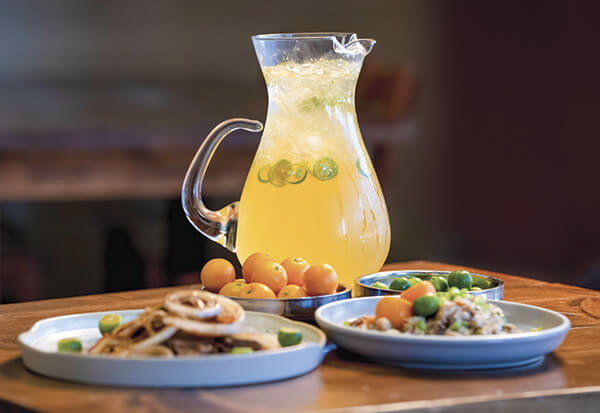
Sparkling juice is a good way to try calamondins, the small, sour citrus fruit that's used widely in Filipino cooking and is poised to break mainstream. Photo: © 2019 Manny Crisostomo
If you live in California and you've never seen, tasted or even heard of a calamondin, you're not alone. Of the many varieties of specialty citrus grown in the state, calamondins are among the least known.
But if you lived in the Philippines, it would be a different story. There, where it's called calamansi or calamonding, the small fruit is ubiquitous. Puckeringly sour, it's used to add acid to dishes, to balance and build the complexity of flavors. A squeeze of the juice bolsters dipping sauces, brightens saucy dishes or finishes a plate of noodles. The fruit also features in Malaysian cooking.
The Philippines is the world's top producer of calamondins. But thanks to a growing population of Filipino American residents in California, and rising interest in Filipino cuisine in the U.S., calamondins have begun to gain ground here both as an ingredient and a crop.
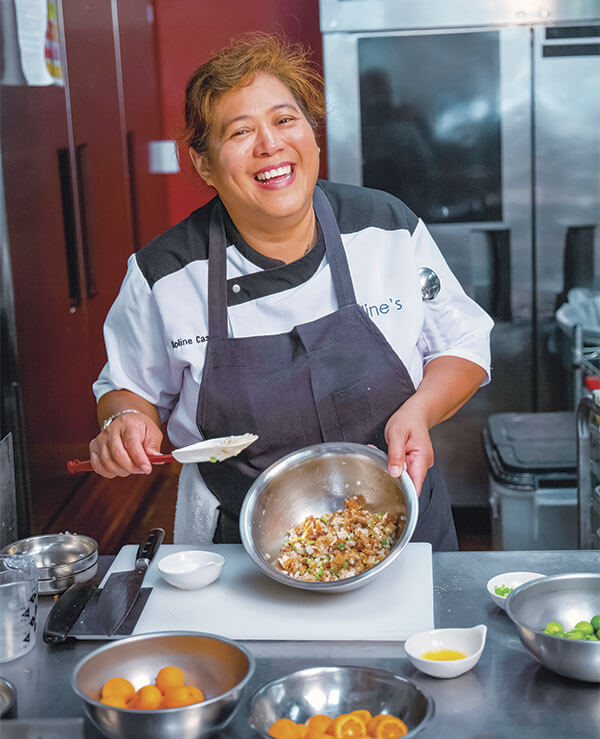
Chef Roline Casper uses juice from calamondins in either the fully ripe orange stage or immature green stage. "It's a small fruit, but it's packed with flavor," she says. Photo: © 2019 Manny Crisostomo
Small but flavorful
The calamondin is believed to be a natural cross of kumquat and mandarin orange, possibly native to China. It was introduced to the United States in about 1900. Because it blooms and bears fruit year-round, the calamondin is a popular ornamental citrus and the most commonly sold potted citrus in the U.S. In fact, quite a few Californians might have calamondins growing in their backyards, homes or neighborhoods without realizing the small, sour fruits have culinary value.
In the Philippines, the fruits are harvested and used when small, green and immature. In California, they're more commonly harvested when orange and fully ripe.
The fruits retain the highly aromatic rind of their kumquat parentage, which is sweet and edible when fully ripe. The fruit's flavor, with floral and medicinal notes, is more complex, softer and slightly sweeter than that of lemon.
"It's a small fruit, but it's packed with flavor," said chef Roline Casper, who grew up in the Philippines and learned to cook from her grandmother. She's owned Roline's Uniquely Filipino, a casual eatery in Vacaville serving traditional, homestyle Filipino food, for 10 years.
"Almost everything that we eat, we always have a dipping sauce with calamansi, fish sauce and soy sauce," she said.
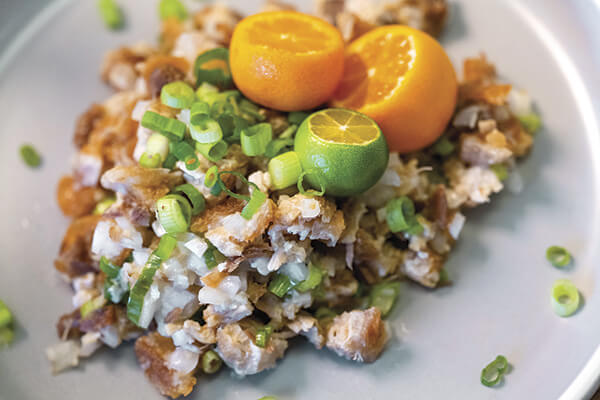
Calamondin juice adds acidic brightness to Filipino dishes across Casper's menu, such as pork sisig. Photo: © 2019 Manny Crisostomo
The salt in the soy sauce and the acid in the citrus juice serve as natural partners, creating rich umami flavors, said Casper, who is a graduate of Napa Valley Cooking School and a sometime instructor there.
She combines calamondin juice with soy sauce, spices, garlic, onions and chili peppers in marinades for bistek—a beef dish—or barbecued meats. Fresh calamondins are served as garnish for pancit noodles and the rice porridge dish arroz caldo, meant to be squeezed on the finished dish before eating. Casper said when she can't find fresh calamondins, she's used limes, but the flavor isn't quite the same.
"With the calamansi, it brings back my childhood memories," she said. "It brings out that little happiness in me whenever I use fresh calamansi."
Calamondin is just one of the essential flavors defining Filipino cooking that Casper takes pleasure in sharing with her diverse customer base.
"Filipino food is here to serve the community," she said. "It's our way of connecting to the people."
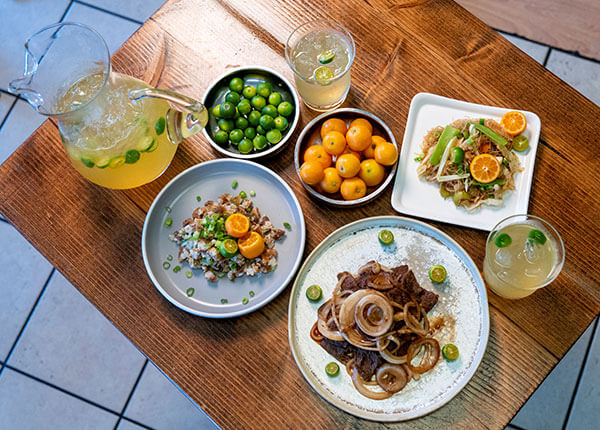
Calamondins are ubiquitous in Casper's native Philippines, where they're called calamansi or calamonding. Photo: © 2019 Manny Crisostomo
Moving mainstream
Casper calls Filipino the original fusion food, arising from Malaysian, Chinese, Spanish, American and Japanese influences. She considers the cuisine an "underdog" of the American food scene, an undiscovered gem.
But the secret about Filipino food might be out. Food writers have been calling Filipino the next "It" cuisine for years. Popular new restaurants helmed by young Filipino American chefs, such as LASA in Los Angeles, offer modern takes on traditional dishes and court a diverse clientele.
And the calamondins that so often accompany the cuisine are also gaining notice from new admirers.
The Washington Post included calamansi juice in its 2019 list of trending flavors. Food blogs abound with recipes using the citrus, such as pie, cake, cookies, cocktails and fish dishes. Marmalade makers attest to the fruit's ability to produce a superior preserve due to its thin, fragrant skin.
"It's more mainstream than you think," said Destiny Marquez, who handles the business side of Pearson Ranch, a grower and online retailer of citrus in Porterville. Pearson Ranch grows oranges and partners with other farmers to offer a variety of specialty citrus to its mail-order customers.
She's seen modest but steady, year-round demand for calamondins from customers all over the country. Increased visibility of specialty citrus on cooking shows and in grocery stores, bars and restaurants has piqued consumers' interest, Marquez said.
"People get excited because they're able to try these new things and they love it," she said. "I think that as America's palate becomes more educated, that's just not going to go away."
Marquez's customers are often interested in using orange, ripe calamondins to make preserves, which she says go especially well with pork. Fully ripe fruits can also be eaten fresh—sweet rind and juicy, sour flesh alike—like a kumquat.
"They're a little bit bitter, but they're sweet and they're tart and you can eat the whole thing and they're wonderful," Marquez said.

Citrus farmer Arlen Miller inspects fruit on his calamondin trees. Photo: © 2019 Tomas Ovalle
Trying something new
For Arlen Miller, who grows the calamondins that Marquez sells, capitalizing on the rising interest in specialty citrus helped his 70-year-old family farm diversify.
He began planting specialty citrus varieties about 10 years ago on a portion of his 600 acres in Orosi, Tulare County, the state's top county for citrus production. In addition to navel and Valencia oranges, lemons and mandarins, he now grows about eight specialty varieties, including Buddha's hand citrons, Tahitian pummelos, variegated pink lemons, Australian finger limes, mandarinquats and calamondins.
Miller said he enjoys the constant challenge of trying to find the optimum method for growing the best fruit.
"We want to get the biggest sizes that are marketable, the sweetest fruit, varieties that people enjoy eating. It's not easy to find all those things," Miller said. "Every year, I get another chance to do it better than I did last year."
Growing calamondins is a little different, Miller said. Unlike oranges, which blossom once in the spring for a crop that ripens the following winter, calamondin trees bloom and set fruit three to four times a year. That means blossoms, immature fruit and mature fruit are all on the tree at the same time. The tree becomes quite laden with fruit, Miller said, which can take up to a year to mature on the tree. They're then hand-harvested to order.
In addition to partnering with Pearson Ranch, Miller sells his specialty varieties directly to customers at the farm's fruit stand and via its Facebook page, The Big Orange. He also sells fruit through a wholesaler, which is helping to educate buyers about unfamiliar varieties and develop a slowly growing market. Even so, demand hasn't yet kept up with the supply of fruit his 350 calamondin trees pump out. He'd love for more people to discover them.
Marquez thinks there's potential for a lasting relationship.
"I think once you try 'quats—and calamondin is one of them—it's just so wonderful because it's so bright and there's so much flavor in such a small little package. It's hard to beat," she said.
Recipes
Bistek Tagalog: Filipino beef steak with onions
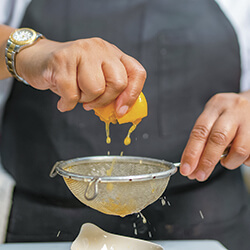
Photo: © 2019 Manny Crisostomo
Calamondins in your kitchen
Calamondins, or calamansi, may be indispensable in Filipino cooking, but can fit anywhere on your menu. Use them whenever a squeeze of lemon or lime is called for.
One of chef Roline Casper's favorite ways to use calamondins is to squeeze five or so of the fruits into a glass and add honey or sugar and sparkling water to make sparkling calamansi juice.
"I suggest you use it as a juice first, and then you'll find it so refreshing you'll squeeze it on whatever you're eating," she said. "It's really good for grilled fish or grilled vegetables, like asparagus."
She's also used a squeeze of calamondin juice on salsa instead of lime, or in raw fish poke. Try substituting calamondin juice for lemon, lime or orange juice in your favorite dipping sauce or marinade recipe.
The peel of the fruit is thin, making it somewhat delicate and perishable. A great way to preserve a batch of calamondins is to squeeze the juice and freeze it in ice cube trays, Casper said. You can toss the cubes in dishes for a bright citrus note.
"Just one goes a long way," Casper said.
Look for fresh calamondins in farmers markets. The fruit is available year-round, but production peaks November through May, and fruit is sweetest at the end of the season. You might also find fresh calamondins at specialty Filipino grocery stores.

